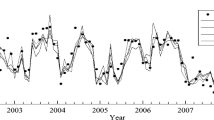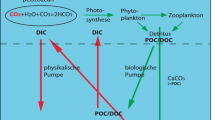Abstract
The Levenberg–Marquardt algorithm was used to train artificial neural networks to predict the abundance of Cyclotella ocellata Pant. and Cyclotella kützingiana Thwaites using time, depth, temperature, pH, dissolved oxygen, and electrical conductivity as input parameters for the oligo-mesotrophic Kuzgun Dam Reservoir, Turkey. The data were collected in monthly intervals during two ice-free seasons: between April 2000–November 2000 and April 2001–November 2001. To reduce over-fitting of the neural network based models, we employed single hidden layer networks with early stopping of training. Correlation coefficients of neural network predictions with measurements of abundance of Cyclotella ocellata Pant. and Cyclotella kützingiana Thwaites were 0.88 and 0. 86, respectively.
Similar content being viewed by others
References
APHA, AWWA, WCPF, 1995. Standard Methods for the Examination of Water and Wastewater, 19th ed., APHA, AWWA, WCPF, Washington, DC: 1268 pp.
Demuth, H. M. Beale, 2000. Neural Network Toolbox User's Guide, The MathWorks Inc., Natick, MA, U.S.A.
Desortova, B. J. Komarkova, 2001, Phytoplankton of the Klicava Reservoir during 1959–1970. Acta Univ. Caroline Environ. 15: 33–55.
Hagan, M.T. M. Menjah, 1994, Training feed-forward networks with the Marquardt algorithm. IEEE Trans. Neural Networks 5(6): 989–993.
Ham, F. M. I. Kostanic, 2001. Principles of Neuro-computing for Science and Engineering, McGraw-Hill International Edition, Electrical Engineering Series, New York: 642 pp.
Huber, P.G., 1961. Das Phytoplankton des Susswassers Systematik und Biologie, Teil 5, Thienemann, A. (ed.), Chlorophyceae (Grunalgen), ordnung volvocales. E. Schweizerbarth'sche Verlagsbuch handlung (Nagele u. Ober-miller), Stuttgart: 943 pp.
Huber, P. G., 1972. Das Phytoplankton des Susswassers Systematik und Biologie, Teil 6, Foot, V.B. (ed.), Chlorophyceae (Grunalgen), ordnung Tetraporales. E. Schweizerbarth'sche Verlagsbuch handlung (Nagele u. Ober-miller), Stuttgart: 173 pp.
Huber, P. G., 1982. Das Phytoplankton des Susswassers Systematik und Biologie, Teil 8: Komarek, J. B. Foot (eds), Chlorophyceae (Grunalgen), ordnung Chlorococcales. E. Schweizerbarth'sche Verlagsbuch handlung (Nagele u. Obermiller), Stuttgart: 543 pp.
Huber, P. G., 1983. Das Phytoplankton des Susswassers Systematik und Biologie, Part 7, Teil 1: Komarek, J. B. Foot (eds), Chlorophyceae (Grunalgen), ordnung Chlorococcales. E. Schweizerbarth'sche Verlagsbuch handlung (Nagele u. Obermiller), Stuttgart: 1044 pp.
Karul, C., S. Soyupak C. Yurteri, 1999. Neural network models as a management tool in lakes. Hydrobiologia 408/409: 139–144.
Kocatas, A., 1997. Ekoloji, Cevre Biyolojisi, Ege Ñniv. Fen Fakültesi, Ders Kitaplari Serisi, No: 5, Ege Ñniv. Basimevi Bornova, Izmir, 564 pp. (in Turkish).
Lund, J. W. G., C. Kipling E. D. Gren, 1958, The inverted microscope method of estimating algal numbers and the statistical basis of estimations by counting. Hydrobiologia 11: 143–170.
Moss, B., 2001. Ecology of Freshwater, Third Edition, Blackwell Science, Oxford: 556 pp.
Nisbet, M. J. Verneaux, 1970. Discussion et proposition de classes entantique bases interpretation des analyses chimiques. Limnologie 6: 161–190.
Parson, T. R. J. D. H. Strickland, 1963. Discussion of spectrophotometric determination of marine plant pigments with revised equations for ascertaining chlorofills and carotenoid. J. mar. Res. 21: 155–163.
Patrick, R. C.W. Reimer, 1966. The Diatoms of the United States. Acad. Sci. Philadelphia, Monarg. Vol. I, 688 pp.
Patrick, R. C.W. Reimer, 1975. The Diatoms of the United States. Acad., Sci. Philadelphia, Monarg. Vol. II, 213 pp.
Rawson, D. S., 1956. Algal indicators of trophic lake types. Limnol. Oceanogr. 1: 18–25.
Recknagel, F., M. French, P. Harkonen K. Yabunaka, 1997. Artificial neural network approach for modeling and prediction of algal blooms. Ecol. Model. 96: 11–28.
Reynolds, C. S., 1984. The Ecology of Freshwater Phytoplankton, Cambridge University Press, Cambridge: 384 pp.
Reynolds, C. S., V. Huszar, C. Kruk, L. Naselli-Flores S. Melo, 2002. Review towards a functional classification of the freshwater phytoplankton. J. Plankton Res. 24: 417–428.
Ryding, S. O. W. Rast, 1989. The Control of Eutrophication of Lakes and Reservoirs, Parthenon Publishing Co., UNESCO, Park Ridge, New Jersey: 314 pp.
Sharma, O. P., 1986. Textbook of Algae. Tata McGraw-Hill Publishing Company Limited, New Delhi: 396 pp.
Vollenweider, R. A. J. J. Kerekes, 1981, Appendix I: Background and summary results of the OECD cooperative program on Eutrophication. In Janus, L.L. R. A. Vollenweider (eds), The OECD Cooperative Programme on Eutrophication: Canadian Contribution Scientific Series 131, Environment Canada, Ottawa: 251–386.
Wetzel, R. G., 1983. Limnology. Saunders College Publishing, Philadelphia, PA: 767 pp.
Wetzel, R. G., 1990. Reservoir ecosystems: conclusions and speculations. In Thornton, K. W., B. L. Kimmel E. F. Payne (eds), Reservoir Limnology: Ecological Perspectives. J.Wiley Sons, New York, U.S.A.: 227–238.
Author information
Authors and Affiliations
Rights and permissions
About this article
Cite this article
Gurbuz, H., Kivrak, E., Soyupak, S. et al. Predicting dominant phytoplankton quantities in a reservoir by using neural networks. Hydrobiologia 504, 133–141 (2003). https://doi.org/10.1023/B:HYDR.0000008513.19329.29
Issue Date:
DOI: https://doi.org/10.1023/B:HYDR.0000008513.19329.29




